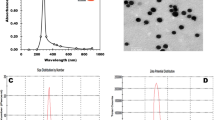Abstract
Rats fed a basal, low-selenium diet, or this diet supplemented with 0.1 ppm and 1.0 ppm selenium and treated with cadmium, showed significant reductions in the activity of the selenoenzyme glutathione peroxidase in kidney and liver. Cadmium treatment resulted in a significant increase in the activity of selenium-independent glutathione peroxidase activity in the liver of selenium-supplemented rats. Selenium-independent glutathion peroxidase activity was significantly reduced in the kidney of rats fed the basal low-selenium diet. There was no significant increase in lipid peroxidation in any of the groups studied. Cadmium concentrations in the kidney and liver of these animals ranged from about 250 to 700 μg Cd/g tissue, dry weight.
Similar content being viewed by others
References
American Institute of Nutrition (1977) Report of the American Institute for Nutrition ad hoc committee on standards for nutritional studies. J Nutr 107: 1340–1349
Aust SD, Svingen BA (1982) The role of iron in enzymatic lipid peroxidation. In: Pryor, W.A. (ed) Free Radicals in Biology, Volume V Academic Press, New York, pp 1–28
Bozkurt A, Smith JC (1981) The interaction between cadmium and selenium in the rat. In: Spallholz JE, Martin JL, Ganther HE (eds) Selenium in Biology and Medicine, AVI Publishing Co., Westport, Conn., pp 331–335
Bradford MM (1976) A rapid and sensitive method for the quantitation of microgram quantities of protein using the principle of protein-dye binding. Anal Biochem 72: 248–254
Burk RF, Lawrence RA, Lane JM (1980) Liver necrosis and lipid peroxidation in the rat as a result of paraquat and diaquat administration: Effects of selenium deficiency. J Clin Invest 65: 1024–1031
Chen RW, Ganther HE (1975) Relative cadmium binding capacity of metallothionein and other cytosolic fractions in various tissues of the rat. Environ Physiol Biochem 5: 378–388
Dalvi RR, Robbins TJ (1978) Comparative studies on the effect of cadmium, cobalt, lead, and selenium on hepatic microsomal monooxygenase enzymes and glutathione levels in mice. J Environ Path Toxicol 1: 601–607
Gabor S, Anca Z, Bordas E (1978) Cadmium induced lipid peroxidation in kidney and testes: Effect of zinc and copper. Rev Rouman Biochim 15: 113–117
Gasiewicz TA, Smith JC (1978) The metabolism of selenite by intact rat erythrocytes in vitro. Chem Biol Interact 21: 299–313
Jamall IS, Smith JC (1985a) Effects of cadmium on glutathione peroxidase, Superoxide dismutase and lipid peroxidation in the rat heart: A possible mechanism of cadmium cardiotoxicity. Toxicol Appl Pharmacol 80: 33–42
Jamall IS, Smith JC (1985b) The effects of dietary selenium on cadmium binding in rat kidney and liver. Arch Toxicol 56: 252–255
Klevay LM, Petering HG, Stemmer KL (1971) A controlled environment for trace metal experiments on animals. Environ Sci Technol 5: 1196–1199
Lauwerys R (1979) Cadmium in man In: Webb M (ed) The chemistry, biochemistry and biology of cadmium elsevier, Amsterdam pp 433–455
Lawrence RA, Burk RF (1978) Species, tissue and subcellular distribution of non-selenium glutathione peroxidase activity. J Nutr 108: 211–215
Masukawa T, Nishimura T, Iwata H (1984) Differential changes of glutathione-S-transferase activity by dietary selenium. Biochem Pharmacol 33: 2635–2639
Meyer SA, House WA, Welch RM (1982) Some metabolic interrelationships between toxic levels of cadmium and nontoxic levels of selenium fed to rats. J Nutr 112: 954–961
Ohkawa H, Ohishi N, Yagi K (1979) Assay for lipid peroxides in animal tissues by thiobarbituric acid reaction. Anal Biochem 95: 351–358
Reddy CC, Scholz RW, Massaro EJ (1981) Cadmium, methyl mercury and lead inhibition of calf liver glutathione -S-transferase exhibiting selenium-independent glutathione peroxidase activity. Toxicol Appl Pharmacol 61: 460–468
Samarawickrama G (1979) Biological effects of cadmium in mammals. In: Webb M (ed) The chemistry, biochemistry and biology of cadmium Elsevier, Amsterdam pp 341–421
Watkinson JH (1966) Fluorimetric determination of selenium in biological material with 2,3-diaminonaphthalene. Anal Chem 38: 92–97
Webb M (1979) The metallothioneins In: Webb M (ed) The chemistry, Biochemistry and biology of cadmium Elsevier, Amsterdam pp 195–266
Author information
Authors and Affiliations
Additional information
Supported by NIEHS Center Grant ES-00159 and a Grant from the Selenium-Tellurium Development Association
Rights and permissions
About this article
Cite this article
Jamall, I.S., Smith, J.C. Effects of cadmium treatment on selenium-dependent and selenium independent glutathione peroxidase activities and lipid peroxidation in the kidney and liver of rats maintained on various levels of dietary selenium. Arch Toxicol 58, 102–105 (1985). https://doi.org/10.1007/BF00348317
Received:
Accepted:
Issue Date:
DOI: https://doi.org/10.1007/BF00348317




